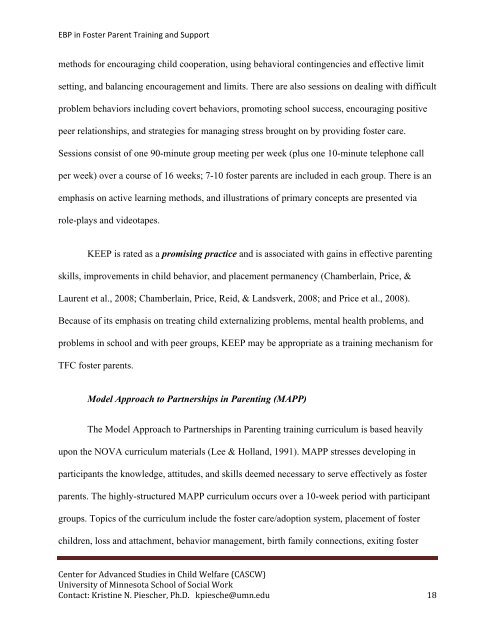Evidence-Based Practice in Foster Parent Training and Support ...
Evidence-Based Practice in Foster Parent Training and Support ...
Evidence-Based Practice in Foster Parent Training and Support ...
Create successful ePaper yourself
Turn your PDF publications into a flip-book with our unique Google optimized e-Paper software.
EBP <strong>in</strong> <strong>Foster</strong> <strong>Parent</strong> Tra<strong>in</strong><strong>in</strong>g <strong>and</strong> <strong>Support</strong>methods for encourag<strong>in</strong>g child cooperation, us<strong>in</strong>g behavioral cont<strong>in</strong>gencies <strong>and</strong> effective limitsett<strong>in</strong>g, <strong>and</strong> balanc<strong>in</strong>g encouragement <strong>and</strong> limits. There are also sessions on deal<strong>in</strong>g with difficultproblem behaviors <strong>in</strong>clud<strong>in</strong>g covert behaviors, promot<strong>in</strong>g school success, encourag<strong>in</strong>g positivepeer relationships, <strong>and</strong> strategies for manag<strong>in</strong>g stress brought on by provid<strong>in</strong>g foster care.Sessions consist of one 90-m<strong>in</strong>ute group meet<strong>in</strong>g per week (plus one 10-m<strong>in</strong>ute telephone callper week) over a course of 16 weeks; 7-10 foster parents are <strong>in</strong>cluded <strong>in</strong> each group. There is anemphasis on active learn<strong>in</strong>g methods, <strong>and</strong> illustrations of primary concepts are presented viarole-plays <strong>and</strong> videotapes.KEEP is rated as a promis<strong>in</strong>g practice <strong>and</strong> is associated with ga<strong>in</strong>s <strong>in</strong> effective parent<strong>in</strong>gskills, improvements <strong>in</strong> child behavior, <strong>and</strong> placement permanency (Chamberla<strong>in</strong>, Price, &Laurent et al., 2008; Chamberla<strong>in</strong>, Price, Reid, & L<strong>and</strong>sverk, 2008; <strong>and</strong> Price et al., 2008).Because of its emphasis on treat<strong>in</strong>g child externaliz<strong>in</strong>g problems, mental health problems, <strong>and</strong>problems <strong>in</strong> school <strong>and</strong> with peer groups, KEEP may be appropriate as a tra<strong>in</strong><strong>in</strong>g mechanism forTFC foster parents.Model Approach to Partnerships <strong>in</strong> <strong>Parent</strong><strong>in</strong>g (MAPP)The Model Approach to Partnerships <strong>in</strong> <strong>Parent</strong><strong>in</strong>g tra<strong>in</strong><strong>in</strong>g curriculum is based heavilyupon the NOVA curriculum materials (Lee & Holl<strong>and</strong>, 1991). MAPP stresses develop<strong>in</strong>g <strong>in</strong>participants the knowledge, attitudes, <strong>and</strong> skills deemed necessary to serve effectively as fosterparents. The highly-structured MAPP curriculum occurs over a 10-week period with participantgroups. Topics of the curriculum <strong>in</strong>clude the foster care/adoption system, placement of fosterchildren, loss <strong>and</strong> attachment, behavior management, birth family connections, exit<strong>in</strong>g fosterCenter for Advanced Studies <strong>in</strong> Child Welfare (CASCW)University of M<strong>in</strong>nesota School of Social WorkContact: Krist<strong>in</strong>e N. Piescher, Ph.D. kpiesche@umn.edu 18
















